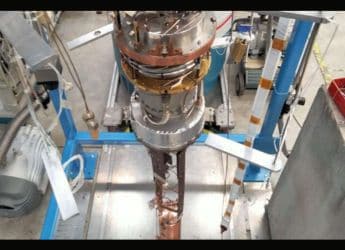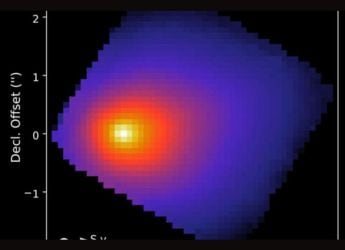- Home
- Science
- Science News
- In a First, Astronomers Watch a Giant Red Star Explode Violently in Real Time
In a First, Astronomers Watch a Giant Red Star Explode Violently in Real Time
The star exploded after it burnt through the hydrogen, helium, and other elements in its core.

Photo Credit: Astrophysical Journal/Northwestern University via CNN
An artist's impression of a red supergiant star releasing a gas cloud in the final year of its life
We have often heard and read about giant stars dying violently in deep space. Ever imagined what kind of a sight it would be? How would a star appear as it nears its end from Earth? We may finally have an answer. In a first for astronomy, researchers were able to see in real time the death by explosion of a giant red star using ground-based telescopes. They saw the star, located 120 million light-years away from Earth in the NGC 5731 galaxy, self-destruct in a dramatic event and collapse in a type-2 supernova.
The scientists said that the star was 10 times more massive than the Sun before it exploded. It erupted after it burnt through the hydrogen, helium, and other elements in its core. Before witnessing this event, astronomers believed that red supergiant stars were relatively calm before exploding into a supernova.
The research, published on January 6 in the Astrophysical Journal, marks a significant milestone in the study of the death throes of stars — those moments before they detonate in violent eruptions.
"This is a breakthrough in our understanding of what massive stars do moments before they die," Wynn Jacobson-Galan, the lead author of the study, said in a statement. “For the first time, we watched a red supergiant star explode."
The star's unusual activity was first detected by astronomers 130 days before it exploded, CNN reported. The University of Hawai's Institute for Astronomy Pan-STARRS telescope detected the bright radiation in the summer of 2020. Later that year, the researchers witnessed a supernova at the same place. Their observations revealed there was material around the star when it exploded.
Astronomers aim to use the research to look through the universe for more stars throwing out radiation and see whether it signals the imminent death of that star. The characteristics of stars are intimately tied to the characteristics of the planetary systems. Consequently, the study of the birth, life, and death of stars is central to the field of astronomy.
Catch the latest from the Consumer Electronics Show on Gadgets 360, at our CES 2026 hub.
Related Stories
- Samsung Galaxy Unpacked 2025
- ChatGPT
- Redmi Note 14 Pro+
- iPhone 16
- Apple Vision Pro
- Oneplus 12
- OnePlus Nord CE 3 Lite 5G
- iPhone 13
- Xiaomi 14 Pro
- Oppo Find N3
- Tecno Spark Go (2023)
- Realme V30
- Best Phones Under 25000
- Samsung Galaxy S24 Series
- Cryptocurrency
- iQoo 12
- Samsung Galaxy S24 Ultra
- Giottus
- Samsung Galaxy Z Flip 5
- Apple 'Scary Fast'
- Housefull 5
- GoPro Hero 12 Black Review
- Invincible Season 2
- JioGlass
- HD Ready TV
- Laptop Under 50000
- Smartwatch Under 10000
- Latest Mobile Phones
- Compare Phones
- OPPO Reno 15 Pro Max
- Honor Win RT
- Honor Win
- Xiaomi 17 Ultra Leica Edition
- Xiaomi 17 Ultra
- Huawei Nova 15
- Huawei Nova 15 Pro
- Huawei Nova 15 Ultra
- Asus ProArt P16
- MacBook Pro 14-inch (M5, 2025)
- OPPO Pad Air 5
- Huawei MatePad 11.5 (2026)
- Xiaomi Watch 5
- Huawei Watch 10th Anniversary Edition
- Acerpure Nitro Z Series 100-inch QLED TV
- Samsung 43 Inch LED Ultra HD (4K) Smart TV (UA43UE81AFULXL)
- Asus ROG Ally
- Nintendo Switch Lite
- Haier 1.6 Ton 5 Star Inverter Split AC (HSU19G-MZAID5BN-INV)
- Haier 1.6 Ton 5 Star Inverter Split AC (HSU19G-MZAIM5BN-INV)

















